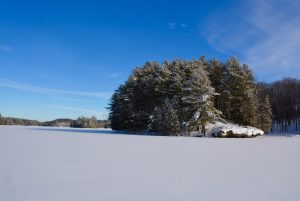Lake Links 2017: “Beyond the Shoreline: Science to Stewardship”
by Gillian Lash
According to the Merriam-Webster dictionary, the definition of stewardship includes “the conducting, supervising, or managing of something; especially the careful and responsible management of something entrusted to one’s care.”
 I believe that the care of the 0.83 hectares of land that I own and its associated shoreline on Buck Lake has been entrusted in me for the future enjoyment of my niece and nephew. I take this responsibility very seriously, which is why I was very excited to participate in the 2017 Lake Links workshop, along with 100 other attendees. This annual one-day workshop was organized by Watersheds Canada.
I believe that the care of the 0.83 hectares of land that I own and its associated shoreline on Buck Lake has been entrusted in me for the future enjoyment of my niece and nephew. I take this responsibility very seriously, which is why I was very excited to participate in the 2017 Lake Links workshop, along with 100 other attendees. This annual one-day workshop was organized by Watersheds Canada.
However, I am not the only one involved in maintaining the fragile and healthy balance between “mother nature” and human enjoyment. This workshop explored the inseparable connection between lakes and upland areas, especially how lake health is impacted by EVERYTHING that lies beyond the shoreline. Scientists, lake associations, and municipal representatives provided their perspectives on cooperative lake protection.
As stewards, we all play an important role in achieving positive outcomes such as optimizing lake shore capacity, improving shoreline protection, increasing the number of good lake stewards and decreasing phosphorus. We can do this by raising our concerns, applying pressure on various governmental agencies and implementing the solution. But these efforts should not be viewed as “one-off”. Environmental management is a process of continuous improvement.
During his presentation, Dr. Neil Hutchinson described such an example. He stated that despite efforts over the last 20 years to counter-act the growth of blue green (cyanobacterial) algal “blooms”, they have increased. These “blooms” can lead to depletion of oxygen in the water and release harmful toxins. Blue green algal “blooms” loves phosphorus, warm waters and still waters.
One lesson that I learned from this workshop is that we should not assume that we know what needs to be done! As we know, the science community is a crucial part of the continuous improvement process and is always learning and refining their research and understanding. For example, they have discovered that one “new” source for the growth in algal blooms is the Zebra mussel. Zebra mussels are invasive species which have accidentally been introduced into Buck Lake. They filter so much water and in such a way that they secrete phosphorous in a more dissolvable form which algal love! This is just one example of why we need to stay informed by continuing our collaboration with conservation authorities.

The other important role in the environmental management process is “political will”. North Frontenac and the Ministry of Natural Resources discussed their roles and the impact.
North Frontenac described how they have enacted minimum lot requirements and shoreline setbacks. The Ministry of Natural Resources emphasized their role in Ontario’s planning system and how they encourage environment stewardship through:
- Conservation Land Tax incentive program
- 100% property tax exemption for land that has important natural heritage features
- Managed Forest Incentive Program
- Landowners with “Managed Forest” pay 25% of the municipal tax rate
I came away from this workshop with a much better understanding of the complexity of environmental management, but also that there are a number of passionate people and organizations that exist to support our efforts as stewards of this magnificent piece of the world, called Buck Lake!
A link to the various presentations made during the 2017 Lake Links workshop can be found here: https://watersheds.ca/lake-links-2017/

